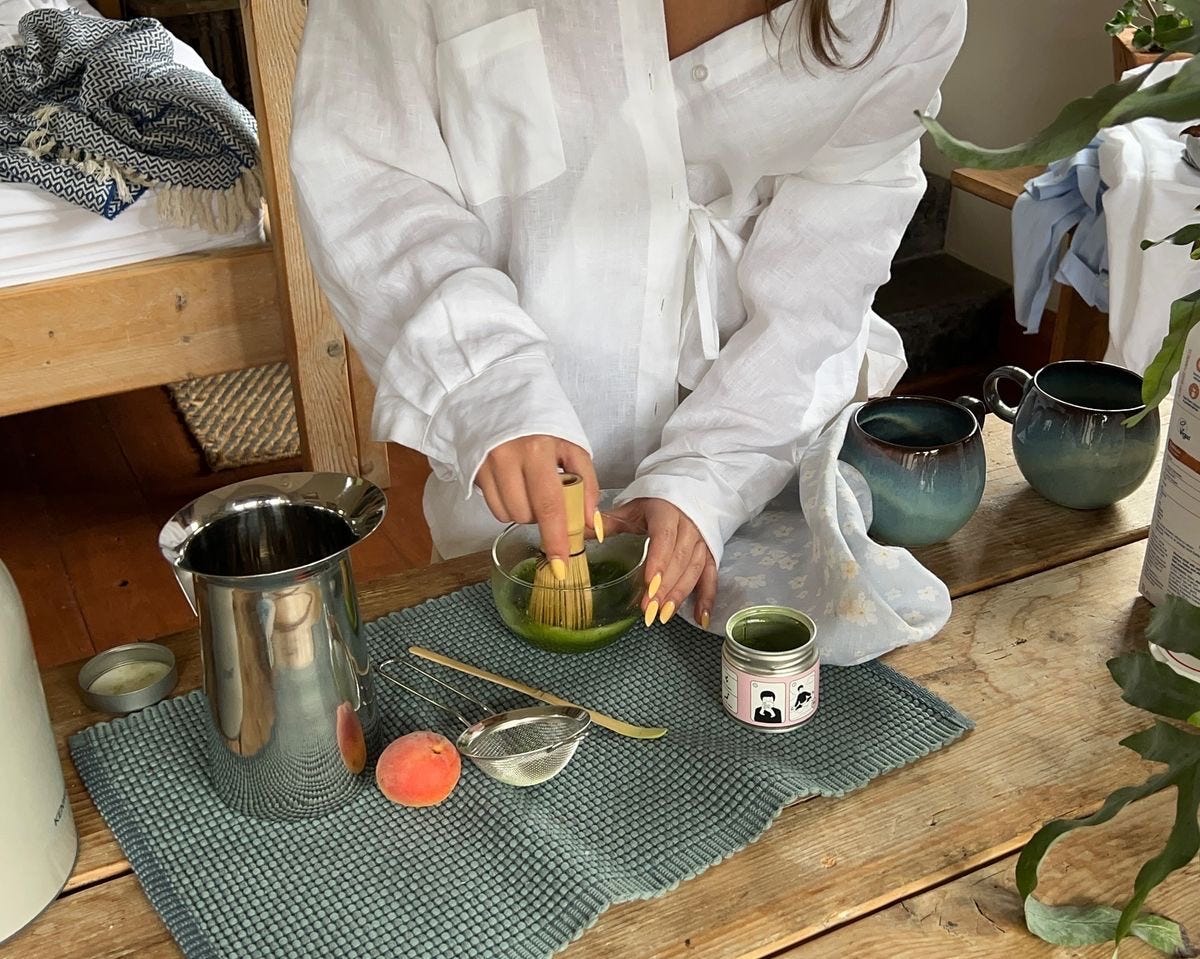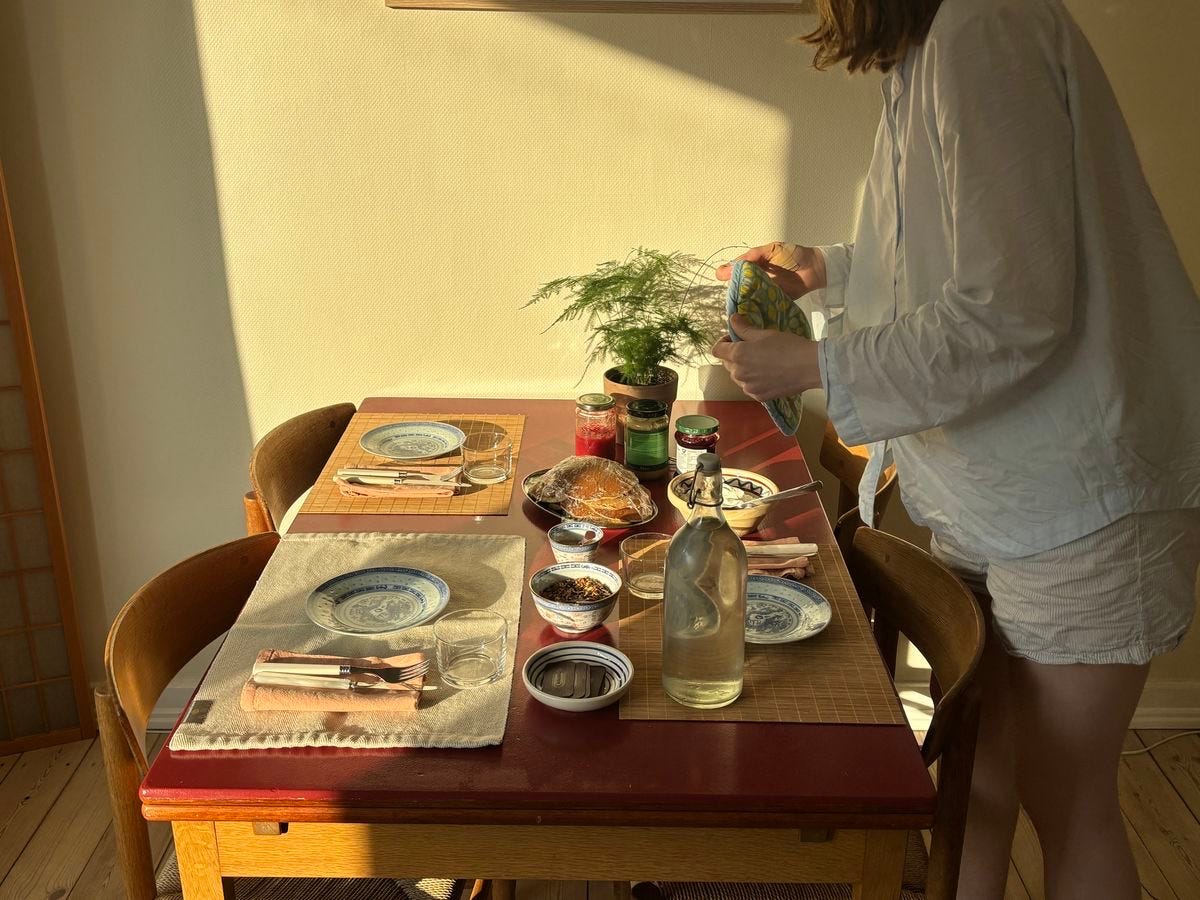i used to think slowness would arrive once i’d earned it. like a reward. once the inbox was emptied. once the laundry was folded. once my relationship felt secure, my body regulated, my child asleep, and the day properly “handled.” then, i imagined, i’d pour tea into a heavy mug and feel something like peace. not performative peace — not the kind that gets styled for a story and then abandoned — but the quiet, felt kind. the kind that makes your jaw unclench without noticing. the kind that belongs to you.
but that moment never really arrived. or when it did, it felt borrowed — like i had to hold my breath while it lasted. like slowness wasn’t something i could live inside of, but something i could visit in small, aesthetic-approved doses. and somewhere between those glimpses of ease and the daily velocity of everything else, i began to wonder if i had misunderstood the entire thing. because for all the times i tried to schedule rest, to plan peace, to build systems of softness into my day — life still felt fast. my nervous system still felt hijacked. and the version of slow living i had internalized — all linen and lavender and golden-hour walks — never really survived the friction of actual reality.
i live in a small apartment. i am raising a child and my dog, louie. i work from home and so does my husband. the logistics of everyday life — groceries, errands, deadlines, dishes that don’t wash themselves, emotional energy that doesn’t regenerate on command — all these things live on top of the version of me that wants to be gentle. and this tension isn’t rare. it’s ordinary. i know women who care for aging parents, friends who juggle three jobs, partners who keep track of everyone’s schedule, freelancers who live inside perpetual instability. none of us are rushing because we enjoy it. we’re rushing because the alternative — stopping — often feels impossible.
and yet, the language of slowness is everywhere. we are sold it as the antidote. the balm. the curated pause we didn’t know we needed. but the version of slow living that dominates our feeds is often hyper-styled and subtly aspirational. it’s spacious kitchens and herbal infusions and women wearing matching sets while slicing figs for breakfast. and while it’s lovely — while there is nothing inherently wrong with that softness — it rarely reflects the pace of a life shaped by caregiving, ambition, financial anxiety, or the invisible labor that fills every gap in the day.
i think the aesthetic of slowness is popular because it gives form to a longing that’s hard to articulate. we want time to feel like ours again. we want to believe in the sacredness of small things. we want to live a life that doesn’t feel like it’s slipping away inside the noise. but when slowness becomes a moodboard instead of a mindset, we start confusing performance with embodiment. we light candles in chaos. we journal between back-to-back calls. we try to turn our healing into something organized and beautiful. and then we feel like we’re failing when it doesn’t stick.
but slow living — as a real, durable practice — has to make room for mess. it has to survive bad lighting, unpaid bills, inconsistent childcare, hormonal exhaustion, and all the unexpected interruptions that real life delivers daily. it has to account for the reality that most of us don’t get to schedule our peace around long empty mornings or silent weekends in the woods. instead, we have to find stillness in the pauses between roles. we have to locate quiet inside a noisy moment, not wait for the moment to go quiet first. and that changes the shape of slowness entirely.
sometimes slowness looks like doing less. sometimes it looks like doing the exact same amount, but with a different internal posture. choosing to breathe slower while doing the dishes. choosing not to spiral when your day gets hijacked. choosing to sit with discomfort instead of immediately trying to fix it. it’s subtle work. invisible, even. and yet it’s where the texture of slow living becomes real — not because the moment is beautiful, but because you stayed present inside it.
there’s also a cultural layer here. for many of us — especially those raised in high-achieving, emotionally avoidant, or immigrant households — slowness was not modeled as safety. slowness was linked to laziness, indulgence, or weakness. urgency felt virtuous. to sit still was to tempt chaos. to be soft was to become vulnerable. and so we became fast. with our thoughts, our decisions, our apologies, our productivity. we learned to get ahead of pain by staying busy. we internalized hustle as self-worth. and now we are collectively exhausted — trying to unlearn speed while still living in systems that reward it.
so no, slow living doesn’t survive real life easily. but that doesn’t mean it can’t exist within it. if we release the pressure for it to look a certain way, we create space for it to emerge in the small, stubborn moments that don’t care about lighting or perfection. moments like standing barefoot on the balcony while the kettle boils. saying no to one more task and letting the silence be awkward. washing your face slowly, even when your inbox is yelling. taking a long route home because the short one feels like a chore. making eye contact with your child for three uninterrupted seconds, just to feel time expand.
what i’ve learned is this: slowness isn’t always soft. sometimes it’s confrontational. sometimes it brings up everything you’ve been too busy to feel. sometimes it makes you realize that the life you’ve built is moving faster than you can emotionally process. and choosing to slow down inside that truth — to face it, to reconfigure around it, to move differently even when no one notices — that’s the real practice.
so can slow living survive real life?
yes. but only if we let it be imperfect. only if we stop expecting it to perform. only if we trust that stillness is not a luxury, but a necessity — even when it has to fit inside five messy, stolen minutes. not aesthetic. not branded. just yours.









While I have enjoyed many of your posts this one was most impactful because you addressed imperfection and the challenge of trying to live intentionally amidst the mess of daily life. This felt real. Thank you.
Beautiful. Not waiting for a quiet Sunday morning on vacation to embrace that pace and peace. An exercise I enjoy is to visualize myself going through my regular, messy, non-slow day with that peaceful, paced feeling as my default setting. A practice!